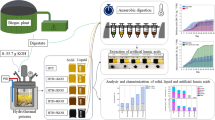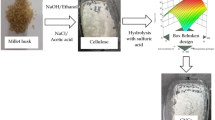Abstract
In this study, ultrasonication was investigated for hydrolysis of sweet lime peel instead of utilizing it as a pretreatment process. Ultrasonication is one of the upcoming hydrolysis techniques that can offer high reducing sugar yield in shorter times and temperature with reduced acid consumption. Optimization studies of the hydrolysis process parameters were carried out to maximize the reducing sugar yield using the Box–Behnken method. From Box–Behnken design, 46 experiments were conducted and the effect of sulfuric acid concentration, peel concentration, sonication time, temperature and amplitude of ultrasound on reducing sugar yield were investigated. Fermentation of the hydrolysate was performed using baker’s yeast and the effect of time and pH on ethanol production was studied. Maximum ethanol yield by fermentation was observed as 64%. Scanning electron micrographs revealed that the regular and compact surface of raw biomass was altered into an irregular and scattered surface as a result of pretreatment and hydrolysis, which showed the prospective feasibility of sulfuric acid assisted steam explosion pretreatment and ultrasound assisted acid hydrolysis. From the experimental study, it was observed that ultrasonication can be explored for hydrolysis of pretreated lignocellulosic biomass to obtain high reducing sugar yield for bioethanol production.
Graphical Abstract



















Similar content being viewed by others
References
Arenas-Cárdenas, P., López-López, A., Moeller-Chávez, G.E., León-Becerril, E.: Current pretreatments of lignocellulosic residues in the production of bioethanol. Waste Biomass Valoriz. 8, 161–181 (2017)
Perlack, R.D., Wright, L.L., Turhollow, A.F., Graham, R.L., Stokes, B.J., Erbach, D.C.: Biomass as feedstock for a bioenergy and bioproducts industry: the technical feasibility of a billion-ton annual supply. Oak Ridge National Lab, Oak Ridge (2005)
Mishra, J., Kumar, D., Samanta, S., Vishwakarma, M.K.: A comparative study of ethanol production from various agro residues by using Saccharomyces cerevisiae and Candida albicans. J. Yeast Fungal Res. 3, 12–17 (2012)
Gaind, S.: Exploitation of orange peel for fungal solubilization of rock phosphate by solid state fermentation. Waste Biomass Valoriz. 8, 1351–1360 (2017)
Rivas-Cantu, R.C., Jones, K.D., Mills, P.L.: A citrus waste-based biorefinery as a source of renewable energy: technical advances and analysis of engineering challenges. Waste Manag. Res. 31, 413–420 (2013)
John, I., Muthukumar, K., Arunagiri, A.: A review on the potential of citrus waste for d-limonene, pectin, and bioethanol production. Int. J. Green Energy. 14, 599–612 (2017)
Zhou, W., Widmer, W., Grohmann, K.: Economic analysis of ethanol production from citrus peel waste. Proc Fla. State Hort. Soc. 120, 310–315 (2007)
John, I., Siddarth, M.S.G., Kalaichelvi, P., Arunagiri, A.: Characterization of citrus peels for bioethanol production. In: Materials, energy and environment engineering, pp. 3–12. Springer, Singapore (2017)
Mohan, S.V., Babu, M.L., Reddy, M.V., Mohanakrishna, G., Sarma, P.N.: Harnessing of biohydrogen by acidogenic fermentation of Citrus limetta peelings: effect of extraction procedure and pretreatment of biocatalyst. Int. J. Hydr. Energy. 34, 6149–6156 (2009)
Mamma, D., Christakopoulos, P.: Biotransformation of citrus by-products into value added products. Waste Biomass Valoriz. 5, 529–549 (2014)
Velmurugan, R., Muthukumar, K.: Utilization of sugarcane bagasse for bioethanol production: sono-assisted acid hydrolysis approach. Bioresour. Technol. 102, 7119–7123 (2011)
Rehman, M.S.U., Kim, I., Chisti, Y., Han, J.-I. et al.: Use of ultrasound in the production of bioethanol from lignocellulosic biomass. EEST A 30, 1391–1410 (2013)
Suslick, K.S., Price, G.J.: Applications of ultrasound to materials chemistry. Annu. Rev. Mater. Sci. 29, 295–326 (1999)
Rokhina, E. V., Lens, P., Virkutyte, J.: Low-frequency ultrasound in biotechnology: state of the art. Trends Biotechnol. 27, 298–306 (2009)
Vilkhu, K., Mawson, R., Simons, L., Bates, D.: Applications and opportunities for ultrasound assisted extraction in the food industry: a review. Innov. Food Sci. Emerg. Technol. 9, 161–169 (2008)
Salamatinia, B., Mootabadi, H., Hashemizadeh, I., Abdullah, A.Z.: Intensification of biodiesel production from vegetable oils using ultrasonic-assisted process: optimization and kinetic. Chem. Eng. Process. Process Intensif. 73, 135–143 (2013)
Phull, S.S., Newman, A.P., Lorimer, J.P., Pollet, B., Mason, T.J.: The development and evaluation of ultrasound in the biocidal treatment of water. Ultrason. Sonochem. 4, 157–164 (1997)
Ashokkumar, M., Grieser, F.: Ultrasound assisted chemical processes. Rev. Chem. Eng. 15, 41 (1999)
Bibi, N., Ali, S., Tabassum, R.: Statistical optimization of pectinase biosynthesis from orange peel by Bacillus licheniformis using submerged fermentation. Waste Biomass Valoriz. 7, 467–481 (2016)
Sadhukhan, S., Sarkar, U.: Production of biodiesel from Crotalaria juncea (Sunn-Hemp) oil using catalytic trans-esterification: process optimisation using a factorial and Box–Behnken design. Waste Biomass Valoriz. 7, 343–355 (2016)
Van Soest, P.J. et al.: Use of detergents in the analysis of fibrous feeds. 2. A rapid method for the determination of fiber and lignin. J. Assoc. Off. Agric. Chem. 46, 829–835 (1963)
John, I., Yaragarla, P., Muthaiah, P., Ponnusamy, K., Appusamy, A.: Statistical optimization of acid catalyzed steam pretreatment of citrus peel waste for bioethanol production. Resour. Technol. (2017). doi:10.1016/j.reffit.2017.04.001
Miller, G.L.: Use of dinitrosalicylic acid reagent for determination of reducing sugar. Anal. Chem. 31, 426–428 (1959)
Das, S.P., Das, D., Goyal, A.: Statistical optimization of fermentation process parameters by Taguchi orthogonal array design for improved bioethanol production. J. Fuels. 2014, 1–11 (2014)
Chauhan, B., Gupta, R.: Application of statistical experimental design for optimization of alkaline protease production from Bacillus sp. RGR-14. Process Biochem. 39, 2115–2122 (2004)
Kumar, A., Prasad, B., Mishra, I.M.: Optimization of process parameters for acrylonitrile removal by a low-cost adsorbent using Box–Behnken design. J. Hazard. Mater. 150, 174–182 (2008)
Qi, B., Chen, X., Shen, F., Su, Y., Wan, Y.: Optimization of enzymatic hydrolysis of wheat straw pretreated by alkaline peroxide using response surface methodology. Ind. Eng. Chem. Res. 48, 7346–7353 (2009)
Harun, M.Y., Radiah, A.B.D., Abidin, Z.Z., Yunus, R.: Effect of physical pretreatment on dilute acid hydrolysis of water hyacinth (Eichhornia crassipes). Bioresour. Technol. 102, 5193–5199 (2011)
Sharma, P., Singh, L., Dilbaghi, N.: Optimization of process variables for decolorization of Disperse Yellow 211 by Bacillus subtilis using Box–Behnken design. J. Hazard. Mater. 164, 1024–1029 (2009)
Chukwumah, Y.C., Walker, L.T., Verghese, M., Ogutu, S.: Effect of frequency and duration of ultrasonication on the extraction efficiency of selected isoflavones and trans-resveratrol from peanuts (Arachis hypogaea). Ultrason. Sonochem. 16, 293–299 (2009)
Tesfaw, A., Assefa, F.: Current trends in bioethanol production by Saccharomyces cerevisiae: substrate, inhibitor reduction, growth variables, coculture, and imobilization. Int. Sch. Res. Not. 2014, 1–11 (2014)
Acknowledgements
The authors wish to thank National Institute of Technology Tiruchirappalli, India under the Ministry of Human Resource Development, India for providing a platform to carry out research and fellowship for Doctoral research to Ms. Indulekha John and GATE Scholarship to Mr. Jishnu P.
Author information
Authors and Affiliations
Corresponding author
Rights and permissions
About this article
Cite this article
John, I., Pola, J. & Appusamy, A. Optimization of Ultrasonic Assisted Saccharification of Sweet Lime Peel for Bioethanol Production Using Box–Behnken Method. Waste Biomass Valor 10, 441–453 (2019). https://doi.org/10.1007/s12649-017-0072-1
Received:
Accepted:
Published:
Issue Date:
DOI: https://doi.org/10.1007/s12649-017-0072-1




